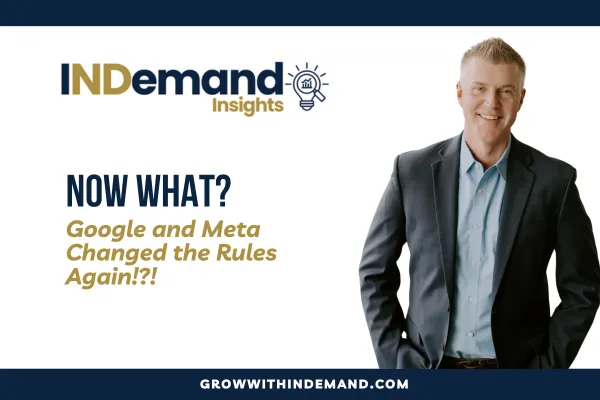
Google & Meta Changes: Marketing Tips for SMBs in 2026
Google and Meta Changed the Rules Again — Now What?
How SMBs Can Stay Ahead When the Digital Giants Keep Shifting the Goalposts
If you feel like your digital marketing strategy is always playing catch-up, you’re not alone.
Just when you finally cracked the code on Google’s latest algorithm or figured out how to get real traction on Facebook and Instagram, boom—the rules change. Again.
For small and medium-sized businesses (SMBs), these constant shifts from tech giants like Google and Meta can feel overwhelming. You’re not running a Fortune 500 marketing department. You’ve got a lean team, limited time, and a bottom line to protect.
So how do you keep up without losing your mind—or your momentum?
Let’s break down what’s changing, why it matters, and what you can do to stay ahead of the game.
The Digital Landscape Is Always Evolving
Every year, Google rolls out multiple algorithm updates. In 2024 alone, we saw core updates that reshuffled SEO rankings, penalized thin content, and rewarded sites that emphasized helpful, experience-based information.
Meanwhile, Meta—parent company to Facebook and Instagram—is constantly tweaking how its ads are served, how organic reach works, and how content gets prioritized in the feed. Add in the recent wave of privacy updates (hello, iOS 17!) and new ad transparency requirements, and you’ve got a recipe for chaos.
The platforms are trying to be more relevant, more ethical, and more engaging. But for SMBs? It can feel like marketing whiplash.
What’s Actually Changed (Lately)
Here’s a quick roundup of major shifts that SMBs should be aware of:
1. Google’s Core Updates Prioritize “Helpful Content”
If your website is stuffed with generic blog posts, poorly written landing pages, or outdated SEO tactics, your ranking likely took a hit. Google’s new priority? Genuine, human-first content based on expertise, experience, authority, and trust—also known as E-E-A-T.
2. Meta’s Ad Targeting Got Another Makeover
With increased pressure around privacy and data use, Meta has limited third-party tracking even further. Interest targeting is getting fuzzier. Custom audiences are more valuable than ever. And creatives—your ad visuals and messaging—now carry more weight than your targeting parameters.
3. AI Is Front and Center in Both Ecosystems
Google’s Search Generative Experience (SGE) and Meta’s AI-powered ad tools mean that machine learning is deciding more and more of what users see and interact with. If you’re not feeding these systems high-quality inputs, you’re invisible.
Why These Changes Matter to You
If you’re not adapting, you’re disappearing.
Too dramatic? Maybe. But the data backs it up.
When Google updates its algorithm, websites can see traffic drop by 30-50% overnight. A recent Meta ads update caused some SMB campaigns to tank in performance while others skyrocketed—all because the rules of engagement shifted behind the scenes.
The problem? Most SMBs don’t realize what’s happening until it’s too late.
If your leads are drying up, your website traffic has slowed, or your ads aren’t converting like they used to… it’s probably not your fault. But it is your problem.
What You Can Do (Without a Massive Budget)
So, what’s a savvy SMB to do? You don’t need a team of 10 or a six-figure media budget—you just need to make smart, proactive moves.
Here’s where to focus:
1. Invest in Better Content—Not Just More Content
Google’s recent updates favor quality over quantity. That means:
Blog posts should be original, experience-based, and helpful.
Service pages should clearly explain what you do and why someone should trust you.
You need real people behind your brand—bios, testimonials, case studies, and photos help.
💡 Pro Tip: Use tools like INDemand’s MktrHub to manage and optimize your content publishing workflow. It’s like having an editorial team in your back pocket.
2. Own Your Data and Build First-Party Audiences
If Meta’s changes taught us anything, it’s this: the businesses with the best first-party data win.
Start collecting:
Email addresses via gated content or newsletter signups
SMS opt-ins during purchases or booking
CRM details from past customers
Then, use that data to fuel lookalike audiences and remarketing campaigns that actually convert.
💡 Need help setting this up? MktrHub can automate list building and sync it to your Meta and Google ad campaigns.
3. Diversify Your Traffic Sources
Relying solely on Google organic or Facebook ads is a risky game. Instead:
Explore Bing Ads—they’ve grown in relevance and are less expensive.
Invest in local SEO via Google Business Profile, local backlinks, and directories.
Try lightweight video content on TikTok or YouTube Shorts for reach and engagement.
Think of it like your retirement portfolio—diversification = stability.
4. Get Smart with Your Ad Creatives
Targeting is no longer your secret weapon—creative is.
That means:
Stop using stock photos and start using branded content.
A/B test copy variations every 2 weeks.
Use video where possible—Meta’s algorithm favors it, and so do users.
5. Stay in the Know (Without Getting Overwhelmed)
You don’t have time to read every Google Search Central blog or sit through a 90-minute Meta webinar.
Instead:
Subscribe to curated marketing newsletters (like INDemand Insights 😉)
Set Google Alerts for "Google algorithm update" or "Meta Ads change"
Work with a consulting partner that keeps their finger on the pulse for you
Adapt, Don’t Panic
Change is constant in digital marketing, but it doesn’t have to derail your growth.
The SMBs that win in this environment are the ones that:
✅ Stay informed
✅ Focus on quality
✅ Build and use their own data
✅ Prioritize creative strategy
✅ Embrace agility over perfection
Platforms like Google and Meta will keep evolving. That’s a given. The key is not to chase every trend but to build a flexible, high-performing system that keeps working—even when the rules change.
And hey—that’s exactly what INDemand was built to do.
